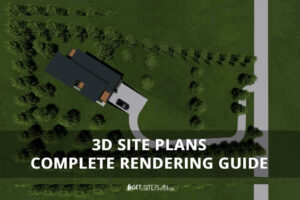
3D Site Plans – Complete Rendering Guide
Before a single foundation is poured or a wall takes shape, every construction project begins with one thing – a plan. But while traditional blueprints show dimensions, 3D site plans


Contributing Writer | Architecture & Design Writer
Building a deck is a great way to transform your outdoor space into a more appealing and functional area for relaxation and entertainment. To ensure the deck’s safety and durability, adhering to specific building codes is essential.
These building codes for decks exist to prevent accidents and ensure the lifespan of the construction. Code regulations address structural integrity and the use of proper materials, and understanding these codes is crucial for a successful deck process.
Stay with us, as we’ll explore deck-building codes while providing you with all the knowledge you need to start your deck project confidently.
Table of Contents
Toggle
Deck code requirements can vary in each area
Building codes provide durable and safe installations. They protect the homeowners and maintain their insurance coverage. Building codes address structural guidelines, stair and railing requirements, materials, and other parts of construction processes.
Every area has different code requirements, so it’s highly important to check with your local building authorities for guidelines and necessary permits for a specific state or city before you start searching for different deck ideas.
There are some general deck-building codes, and they require the following:
Here’s the table showing those general building codes.
| Deck-Building Requirement | Code Specification |
| Wood deck boards | Must use 5/4 or 2″ x 6″ boards for the given span. |
| Composite deck boards | Must follow the manufacturer’s span and installation specifications. |
| Deck height and railings | Railings are required if the deck is more than 30″ above the ground. |
| Stair handrail height | Must be 34″–38″ measured vertically from the stair tread nose. |
| Load strength | Must support a minimum of 50 pounds per square foot. |
| Stairway width | Must be at least 36″ wide. |
| Tread and riser consistency | Tread depth and riser height variations must not exceed ⅜″. |
| Footing post sizes | Can be 4″x4″, 4″x6″, 6″x6″, or 8″x8″ depending on local building codes. |
Table 1: General building codes
Codes can vary depending on whether it’s attached to the house or not, and also on the deck design. Respecting these requirements provides legal compliance and enhances the safety of the deck.
Besides following these codes, obtaining the necessary permits is a crucial step in the deck construction process. In case you are wondering, do you need a building permit for a deck, the answer is – in most cases, yes.
When constructing a deck, having a building permit is an important part of the process, as building without a permit can cause legal issues. The building permit cost ranges between $140 and $3,000 and ensures that all local regulations and safety standards during the deck construction project are met.
Now, let’s discuss different deck parts in more detail.
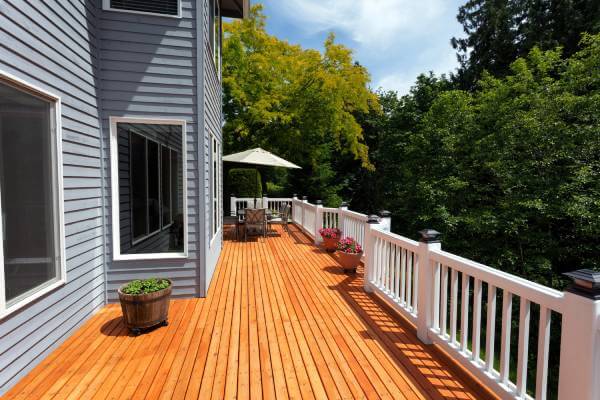
A deck is constructed with different parts, each with a specific function that ensures its durability, safety, and stability. Every part has its building codes that must comply with local regulations. Let’s discuss each deck part and some of its codes in more detail.
Deck railings are there to prevent injuries and falls. There are various railing designs, so you can choose which style fits your aesthetic the most.
To pass the inspection and be in compliance with regulations, you need to know that the railing of a deck has to be 36 inches high for all decks that are higher than 30 inches above the ground and that the spacing and attachment for installing deck guard posts can vary by location, but they should be installed at the corner of the rim joist for the railing.
Decks can’t have stair risers higher than 7 3/4 inches, and the depth of treads has to be at least 10 inches. Stairs with 4 or more risers require handrails that must be positioned between 34 and 38 inches above the tread nosings, as the IRC says.
To prevent shifting during the process of freezing and thawing, footers must extend below the frost line. In colder regions, they need to be deeper than in warmer climates, where they are usually 12 inches deep. The precise depth is defined by the IRC, but it can be changed and adjusted depending on the local climate conditions.
To prevent children and people from slipping through, baluster spacing in deck railings can’t be more than 4 inches. This is a very important requirement that is outlined in the IRC.
The framing of a deck includes the joists, ledger board, and the beams that support the deck. Details on load capacities and materials are specified more in the IRC.
To support the deck’s load, support posts have to be put precisely, of adequate size, and spaced in a way that they can support the deck.
Deck joists need to be spaced 12” or 16” in the center for most materials, but other materials, such as wood decking and some composites, can go up to 24” in the center. Blocking rows should be installed every 4′ to 6′ for better stability. To attach the joists to the beam securely, use joist hangers that match the required capacities.
Here’s a table showing codes and specifications for different deck parts.
| Deck Part | Code Requirement |
| Deck Railing | Min. height: 36″ (if deck > 30″ above ground); post at rim joist corners |
| Deck Stairs | Max riser: 7¾″; min tread depth: 10″; handrail height: 34–38″ (if ≥4 risers) |
| Deck Footers | Depth: ≥12″ (varies by climate; must go below frost line) |
| Baluster Spacing | Max gap: 4″ |
| Deck Framing | Follow IRC specs for loads and materials |
| Support Posts | Size and spacing must support full deck load (e.g., 4×4, 6×6, etc.) |
| Deck Joists | Spacing: 12″, 16″, or 24″ on center; blocking every 4′–6′; use rated hangers |
Table 2: Specifications and codes for different deck parts.
Now, let’s discuss building codes for residential decks in more detail.
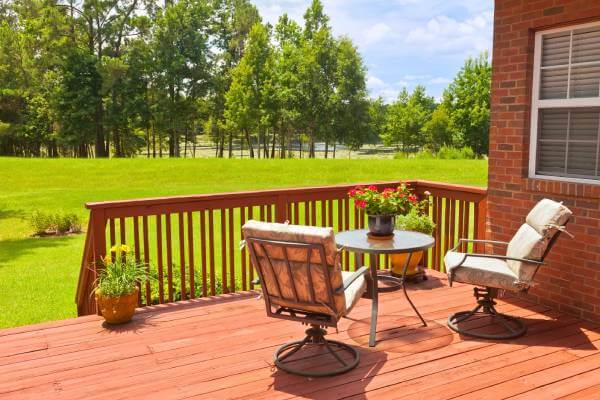
A residential deck is an outdoor structure mostly made from different composite materials or wood and attached to a building or a house. If planning to construct a residential deck, respecting building codes to maintain structural integrity, safety, and compliance with local laws is important.
Some of the requirements for residential decks include:
The table below summarizes building codes for residential decks.
| Deck Component | Code Requirement |
| Footings | Depth: ≥12″ (must extend below frost line) |
| Guardrails | Required if deck height > 30″; min. height: 36″; max. baluster gap: 4″ |
| Stairs | Max riser: 8″; min tread depth: 10″; handrail height: 34–38″ (if ≥4 steps) |
| Ledger Board | Must use bolts or lag screws (no nails); proper flashing required |
| Joist Spans | Example: 2×10 joist @ 16″ OC spans up to 14′ |
| Load Requirements | Live load: 40 psf; dead load: 10 psf |
Table 3: Residential deck building codes
For more specific requirements, always consult the local building department. In the text below, we’ll discuss different deck types and their codes.
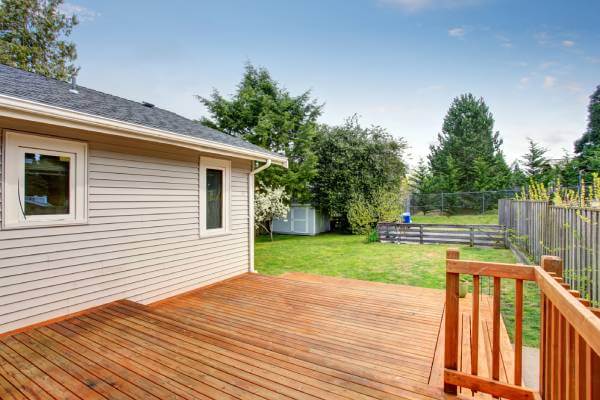
Decks can be designed in many different ways so they can fit specific needs and environments. Understanding the requirements of each type is essential for a successful project. Let’s see some of the most common deck types and their codes.
As its name suggests, this type of deck stands independently, as it’s a structure that’s not attached to any building. The codes for this type of deck must have proper bracing and anchoring to make sure the structure is stable.
Deck codes for this type of deck include ledger board attachment, flashing, and proper joist hangers to prevent any possible water damage.
Ground-level decks or floating decks are built close to the ground and not attached to any structure. Codes for these decks include proper drainage, ventilation, and moisture barriers.
Codes for this type of deck usually refer to the type of wood that can be used and standards for structural components like railings, beams, and joists.
After exploring different deck types, the most important thing to consider is the codes that regulate not only deck construction but also construction in general.
Let’s find out everything about IRC and IBC codes, as they play a crucial role in making sure that all decks meet structural standards and safety regulations.
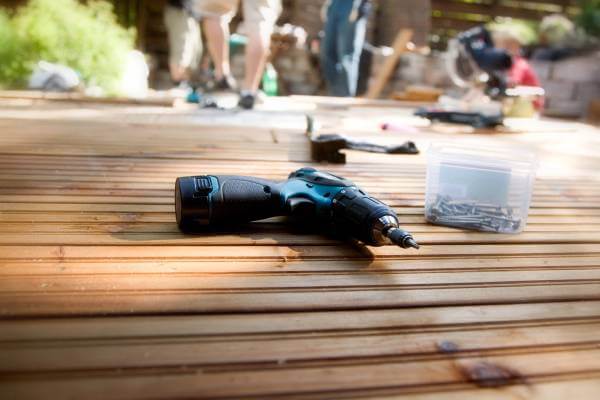
The International Residential Code (IRC) and the International Building Code (IBC) are a set of rules and regulations that set up the minimum standards for the construction of buildings, including decks.
They are established by the International Code Council (ICC) and they represent the basis for codes all over the USA and many other countries.
The IRC:
On the other hand, the IBC:
The differences show that the IRC is designed for smaller-scale residential projects, while the IBC is used for more different of building types.
These codes are crucial for deck building as they ensure compliance with local rules and regulations, as well as the safety and structural integrity of a deck. By following them, we prevent deck failures.
Now, in the following text, let’s see the codes when it comes to different states.

Building codes for decks can vary from state to state because of differences in climate, soil conditions, and local regulations. Many states follow the previously mentioned IRC as a baseline, but there’s also a need for modifications to address certain local needs.
States with colder climates need deeper footings to extend below the frost line, while states that are closer to the coast have stricter rules when it comes to flood resistance and wood. Many states have specific rules when it comes to stair dimensions, railing heights, and materials.
Let’s see some of the specific code requirements for different states.
The building code for residential decks in Virginia has to comply with the IRC, along with some local modifications. Some of the specific requirements are that deck footings have to extend below the frost line, which is around 24 inches, and guardrails have to be over 30 inches high and attached to the house properly.
The state of Ohio has its own Ohio Residential Code that respects the rules of the IRC. Specific regulations include that footings have to be below the frost line, 32 inches deep, and guardrails need to be over 30 inches in height with baluster spacing that is no more than 4 inches.
In the state of Michigan, decks that are higher than 30 inches need to have guardrails that are at least 36 inches tall. The balusters must be spaced no more than 4 inches apart, with footings that are extended below the frost line, which in some areas, can be up to 43 inches deep.
Deck building codes for Florida are focused on hurricane and wind resistance so that decks are safe to withstand strong winds. In Florida, decks that are higher than 30 inches must have guardrails that are at least 36 inches tall, with unique requirements for materials and fasteners for preventing corrosion in coastal areas.
Before starting any construction, be sure to check the rules and regulations with your local building department so you can have a safe and smooth construction process.
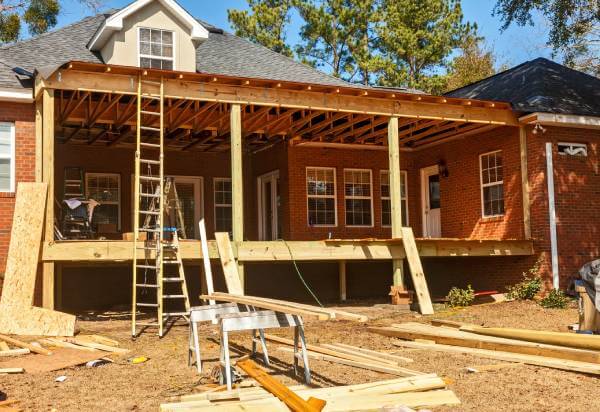
By following deck-building codes, we ensure the safety of the homeowners and visitors. These codes reduce the risks of any potential collapses, accidents, and costly repairs and provide structural integrity.
And to meet all legal requirements before the construction process begins, don’t forget to obtain a site plan for permits. It’s a crucial step for a successful project.
If you need help with obtaining a site plan, feel free to contact us. Our experienced team will be more than happy to answer all your questions. We provide detailed and accurate plans that meet all requirements and ensure a successful process.
Learn more about our contributor:

Contributing Writer | Architecture & Design Writer
During my career, I’ve written articles on interior design, home remodeling, and renovation with an emphasis on money-saving tips and DIY ideas. It’s been a rewarding journey and I am thrilled to continue helping others bring their architectural visions to life.

Before a single foundation is poured or a wall takes shape, every construction project begins with one thing – a plan. But while traditional blueprints show dimensions, 3D site plans

Many homeowners start landscaping projects without realizing some require permits. A landscape permit helps ensure compliance with local codes, protects the environment, and prevents drainage or structural problems. Whether you
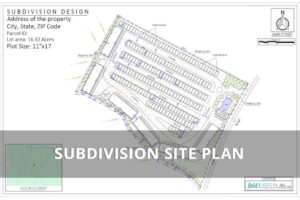
Picture standing over a blueprint that shows the future of your land – where roads will curve, how each lot will breathe, where every pipe, fence, and tree will fit.